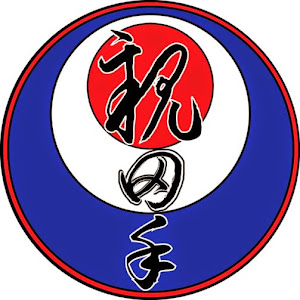One
our fundamental principles is
that motions remain (naturally) side-orientated. This means that the
Left arm deals with motions on the Left side of the body, and the
Right hand/arm deals with those motions on the Right-side of the
body. Though sounding "simplistic" it (evidently) is a
foreign concept to most individuals. Inevitably when an aggressor
delivers a punch (with either hand) student's will (initially) use
their dominant hand (regardless of which side the Uke's strike is
being delivered from) to respond to that strike. .
Oyata believed and
taught that we should use the arm that is on the side that the strike
is being delivered from (right arm for the aggressor's left-hand
strike and vice versa). Aside from being faster, it is a more
practical way to deal with one's defense. This principle is ingrained
into our student's via their practice of the shown techniques.
Initial Arm Motion Practice
This practice introduces the student to
the defensive principle of "Off-Body" (defensive) motion.
The practice of this motion instills the concept of the defensive
action occurring at a distance (away) from the student.
This motion begins with the hand
motioning forward (at the motioning arm's shoulder) forward, and
rising to shoulder height "Palm-Up". The hand then rotates
(Palm-Inward) and moving to the student's center-line, and rotating
to Palm-Down (bending at the arm's elbow to do so). When the hand
reaches the center-line of the body, The hand and elbow are lowered
to waist level. The hand then motions towards the outside of the
student's body, stopping when again aligned with the shoulder
(Palm-Out).
While performing this motion (with one
arm), the student's other arm will perform a separate action.
That arm (what will be referred to as
being the "near/close" arm) will motion across the body
(providing a "groin cover" while doing so) and then raise
(bending at the elbow to do so). That hand continues to rise until
achieving a vertical positioning (again) "in-line" with
it's own shoulder. The elbow and forearm will then be extended
forward (as if/when "striking" with that forearm).
For the practice of "this"
initial action, the arm is not extended. This practice is only
intended to acclimate the student to the combined action performed by
both arm's.
The student should focus on the
extended arm performing it's motions off/away from the student's
body. The secondary hand/arm's motions are (initially) performed
"close" to the student's body.
When this basic motion is understood,
the student will include the rotation of their body (to both the Left
and Right) in conjunction with the performed actions. That "rotation"
should be made so the student assumes a "back-stance"
(initially).
Once the student is comfortable with
the (entire) motion(s), they will begin practice of the motions in
response to an aggressor (uke) performing "Striking"
actions (1 of the 4 possible).
This practice represents the First
Defensive Action Set.
Windmill/Bicycle Application
When the student begins their practice
of the primary motions, they will commonly perform them in such a way
as the motion fails to achieve the desired responses/positions being
done by the uke. This is often compensated for by the tori repeating
the action. This can occur several times, prior to the tori
reversing the action/motion (and the repositioning of the tori) to
then apply the defensive action.
This concept can be applied in either a
sideways, or a forward manner. when performed sideways, it is
referred to as being a "windmill"(as a Right/Left) action.
When done as a forward/backward motion, it is called a "bicycle"
motion.
It is most easily
demonstrated with a Left inside parry followed by a Right outside
parry (followed by another Left inside parry, and another Right
outside parry, etc.). At an appropriate time, the motion is reversed,
and the technique/application is again attempted. Exactly when the
technique is reversed, is up to the tori (dictated by the
circumstances).


No comments:
Post a Comment